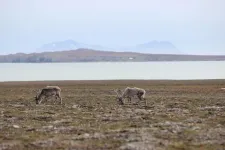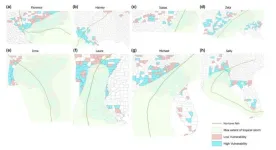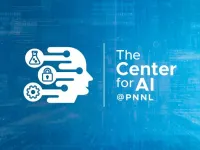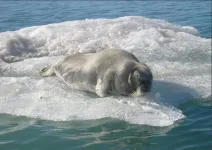(Press-News.org) Quantum information scientists are always on the hunt for winning combinations of materials, materials that can be manipulated at the molecular level to reliably store and transmit information.
Following a recent proof-of-principle demonstration, researchers are adding a new combination of compounds to the quantum materials roster.
In a study reported in ACS Photonics, researchers combined two nanosized structures — one made of diamond and one of lithium niobate — onto a single chip. They then sent light from the diamond to the lithium niobate and measured the fraction of light that successfully made it across.
The greater that fraction, the more efficient the coupling of the materials, and the more promising the pairing as a component in quantum devices.
The result: An extraordinary 92% of the light made the jump from diamond to lithium niobate.
“By putting these two material platforms together and channeling light from one to the other, we show that, instead of working with just one material, you can really have the best of both worlds.” — Hope Lee, Stanford University
The research was supported in part by Q-NEXT, a U.S. Department of Energy (DOE) National Quantum Information Science Research Center led by DOE’s Argonne National Laboratory. Stanford University’s Amir Safavi-Naeini and Jelena Vuckovic led the study.
“It was an exciting result to get 92% efficiency from this device,” said Hope Lee, paper co-author and a Ph.D. student at Stanford University and researcher who worked with Q-NEXT Director David Awschalom while an undergraduate at the University of Chicago. “It showed the advantages of the platform.”
A bit about qubits
Quantum technologies harness special features of matter at the molecular scale to process information. Quantum computers, networks and sensors are expected to have an enormous impact on our lives in areas such as medicine, communication and logistics.
Quantum information is delivered in packets called qubits, which can take many forms. In the research team’s new platform, qubits transmit information as particles of light.
Reliable qubits are critical for technologies such as quantum communication networks. As in traditional networks, information in quantum networks travels from one node to another. Stationary qubits store information within a node; flying qubits carry information between nodes.
The research team’s new chip would form the basis of a stationary qubit. The more robust the stationary qubit, the more reliable the quantum network, and the greater the distance that networks can cover. A quantum network spanning a continent is well within reach.
A material advantage
Diamond has long been touted as a great home for qubits. For one, diamond’s molecular structure can be easily manipulated to host stationary qubits. For another, a diamond-hosted qubit can maintain information for a relatively long time, meaning more time for performing computations. Also, computations performed using diamond-hosted qubits exhibit high accuracy.
Diamond’s partner in the group’s study, lithium niobate, is another star performer when it comes to processing quantum information. Its special properties give scientists versatility by allowing them to change the frequency of the light passing through it. For example, researchers can apply an electric field or a mechanical strain to the lithium niobate to adjust how it channels light. It’s also possible to flip the orientation of its crystal structure. Doing this at regular intervals is another way to shape light’s passage through the material.
“You can use these properties of the lithium niobate to convert and change the light coming from the diamond, modulating it in ways that are useful for different experiments,” said Jason Herrmann, paper co-author and a Ph.D. student at Stanford. “For instance, you can basically convert the light into a frequency used by existing communications infrastructure. So those properties of lithium niobate are really beneficial.”
A powerful pairing
Traditionally, light from diamond-hosted qubits is channeled into either a fiber-optic cable or free space. In both cases, the experimental setup is unwieldy. Fiber-optic cables are long, dangly and floppy. And transmitting qubits into free space requires bulky equipment.
All that equipment goes away when light from the diamond’s qubits is instead channeled into lithium niobate. Nearly every component can be placed on one tiny chip.
“There’s an advantage to having as many of your devices and your functionalities as possible on a single chip,” Lee said. “It’s more stable. And it really allows you to miniaturize your setups.”
Not only that, but because the two devices are connected by a whisper-thin filament — 1/100 of the width of a human hair — the quantum light is squeezed into the narrow passage that leads to lithium niobate, increasing the light’s interaction with the material and making it easier to manipulate light’s properties.
“When all the different light particles are interacting together in such a small volume, you get a much higher efficiency in the conversion process,” Herrmann said. “Being able to do this in the integrated platform will hopefully give rise to much higher efficiencies compared to the setup with fibers or free space.”
A challenging assembly
One of the challenges of developing the platform was manipulating the diamond — a mere 300 nanometers wide — to align with the lithium niobate.
“We had to poke at the diamond with tiny little needles to shift it around until it visibly looked like it was in the correct spot on this plate,” Lee said. “It’s almost like you’re poking at it with little chopsticks.”
Measuring the transferred light was another painstaking process.
“We have to really make sure we’re accounting for all the places where light is transmitted or lost to be able to say, ‘This is how much is going from diamond to lithium niobate,’” Herrmann said. “That calibration measurement took a lot of back and forth to make sure we were doing it correctly.”
The team is planning further experiments that leverage the quantum-information advantages offered by diamond and lithium niobate, both separately and together. Their latest success is only one milestone in what they hope will be a diverse menu of devices based on the two materials.
“By putting these two material platforms together and channeling light from one to the other, we show that, instead of working with just one material, you can really have the best of both worlds,” Lee said.
This work was supported by DOE’s Office of Science National Quantum Information Science Research Centers as part of the Q-NEXT center. It was also supported by the U.S. National Science Foundation and the Swiss National Science Foundation.
END
A promising pairing: Scientists demonstrate new combination of materials for quantum science
Diamond and lithium niobate are combined to serve as a core component for future quantum technologies
2023-12-14
ELSE PRESS RELEASES FROM THIS DATE:
Move over Blitzen: geese outpace reindeer impacts on Arctic ecosystems
2023-12-14
In the frigid seas halfway between mainland Norway and the North Pole, two types of animals browse the palatable vegetation of a high-tundra archipelago, munching on thick moss, cropped grasses and low-lying shrubs. New research from a group led by Matteo Petit Bon from the Quinney College of Natural Resources is working to untangle the ecosystem impacts that two major players — geese and reindeer — have on a changing and vulnerable Arctic system.
Reindeer have been year-round residents on the islands of Svalbard for thousands of years, but at one point were almost completely gone. Svalbard ...
Research shows disadvantaged people wait significantly longer for power restoration after major storms
2023-12-14
Hurricanes and other extreme weather events often affect disadvantaged communities more severely, and extended power outages are some of the most harmful effects. Concerns over the intensification of hurricanes has led to new environmental justice policies that aim to mitigate the unequal impacts of major storms. Now, policy experts and engineers are directing their attention toward illuminating the causes.
Researchers at the Georgia Institute of Technology sought to investigate whether socioeconomically vulnerable households experienced longer power outage durations after extreme weather events. The team analyzed data from the top eight major Atlantic hurricanes between 2017 ...
PNNL creates Center for Artificial Intelligence
2023-12-14
RICHLAND, Wash.—The Department of Energy’s Pacific Northwest National Laboratory has created the Center for AI @PNNL to coordinate the pioneering research of hundreds of scientists working on a range of projects focused on science, security and energy resilience.
Researchers at PNNL were among the first to dive into artificial intelligence decades ago. But AI has surged in the past year with the ready availability of generative AI, which allows almost anyone to produce sophisticated—though sometimes errant—text and images with just a small amount of data. At the same time, AI is a vital tool for ...
Photonics research reveals potential for next-gen AR/VR and IoT
2023-12-14
USD$200,000 awarded to tackle today’s pressing consumer technology demands
Utilizing smart optical sensors for IoT
Providing more realistic virtual and augmented realities
WASHINGTON – The Optica Foundation today released more detailed information on information technology research funded by the 2023 Optica Foundation Challenge. Researchers Zaijun Chen, University of Southern California, USA, and Alejandro Velez-Zea, Universidad de Antioquia, Colombia, both proposed novel approaches to addressing the flow of data and information in consumer-centric technologies.
“The ...
Jurors recommend death penalty based on looks, but new training can correct the bias
2023-12-14
Certain facial features—like downturned lips and a heavy brow—are known to make someone appear untrustworthy to others, even though these do not indicate a person’s actual character. Such facial biases influence our everyday social interactions as well as high-stakes decisions, including who we hire, or elect to political office.
But a new study by Columbia researchers shows that the effects of these judgments can be mitigated. The study outlines the results of four experiments that the authors conducted with 1,400 volunteers. Through those experiments, the researchers found that when real-world defendants have facial features that appear untrustworthy, they are more likely ...
Closing the design-to-manufacturing gap for optical devices
2023-12-14
Photolithography involves manipulating light to precisely etch features onto a surface, and is commonly used to fabricate computer chips and optical devices like lenses. But tiny deviations during the manufacturing process often cause these devices to fall short of their designers’ intentions.
To help close this design-to-manufacturing gap, researchers from MIT and the Chinese University of Hong Kong used machine learning to build a digital simulator that mimics a specific photolithography manufacturing process. Their technique utilizes real data gathered from the photolithography system, so it can more ...
Seals stay warm and hydrated in the arctic with larger, more convoluted nasal passages
2023-12-14
Arctic seals have evolved many adaptations to cope with their frosty environment—one that you might not immediately think of is the bones in their nasal cavity. Arctic seals have more convoluted nasal passages than seal species that live in milder environments, and researchers report December 14 in the Biophysical Journal that these structures help the seals more efficiently retain heat and moisture as they breathe in and out.
“Thanks to this elaborate structure in their nasal cavities, Arctic seals lose less heat through nasal heat exchange than subtropical seals when both are exposed to the same ...
D-mannose reduces age-triggered changes in urinary tract that increase susceptibility to UTIs
2023-12-14
Aging poses a number of challenges to the body’s well-being, one of the most important being an increased susceptibility to multiple diseases, including urinary tract infections (UTIs). The connection between aging and more prevalent UTIs is not well understood, but now researchers at Baylor College of Medicine have found an explanation.
The researchers show in the journal Developmental Cell that, compared to the younger counterpart, the aging urinary tract in animal models changes how it functions at the cellular level in ways that seem to favor the establishment ...
Where patients live impacts whether they pick up their heart-failure medications
2023-12-14
People who live in neighborhoods with higher levels of poverty and unemployment are less likely to fill their heart-failure drug prescriptions than those living in wealthier areas, a new study shows. The findings not only add to understanding geographic and economic disparities in heart disease care, but also point to new ways to address barriers for patients taking these lifesaving drugs.
Led by researchers at NYU Grossman School of Medicine, the study explored prescription pickup patterns among patients with systolic heart failure, a chronic, life-threatening ...
Animal behavior: Cats like to fetch when they’re feline playful
2023-12-14
Cats tend to dictate games of fetch with their owners and most cats who play fetch learned to do so without explicit training, according to a survey of 924 cat owners published in Scientific Reports. The findings also highlight the variety of objects that cats prefer to fetch, including hair ties and bottle parts.
Jemma Forman, Elizabeth Renner and David Leavens surveyed cat owners who reported fetching behaviours in 1,154 cats that they currently or previously owned. Owners reported how fetching first occurred, how often it occurs ...
LAST 30 PRESS RELEASES:
New study shows how the spleen helps the immune system accept a transplant
New Mayo Clinic study advances personalized prostate cancer education with an EHR-integrated AI agent
Researchers identify novel therapeutic target to improve recovery after nerve injury
Microbes in breast milk help populate infant gut microbiomes
Reprogramming immunity to rewrite the story of Type 1 diabetes
New tool narrows the search for ideal material structures
Artificial saliva containing sugarcane protein helps protect the teeth of patients with head and neck cancer
Understanding the role of linear ubiquitination in T-tubule biogenesis
Researchers identify urban atmosphere as primary reservoir of microplastics
World’s oldest arrow poison – 60,000-year-old traces reveal early advanced hunting techniques
Bristol scientists discover early sponges were soft
New study uncovers how rice viruses manipulate plant defenses to protect insect vectors
NSF–DOE Vera C. Rubin Observatory spots record-breaking asteroid in pre-survey observations
Ribosomal engineering creates “super-probiotic” bacteria
This self-powered eye tracker harnesses energy from blinking and is as comfortable as everyday glasses
Adverse prenatal exposures linked to higher rates of mental health issues, brain changes in adolescents
Restoring mitochondria shows promise for treating chronic nerve pain
Nature study identifies a molecular switch that controls transitions between single-celled and multicellular forms
USU chemists' CRISPR discovery could lead to single diagnostic test for COVID, flu, RSV
Early hominins from Morocco reveal an African lineage near the root of Homo sapiens
Small chimps, big risks: What chimps show us about our own behavior
We finally know how the most common types of planets are created
Thirty-year risk of cardiovascular disease among healthy women according to clinical thresholds of lipoprotein(a)
Yoga for opioid withdrawal and autonomic regulation
Gene therapy ‘switch’ may offer non-addictive pain relief
Study shows your genes determine how fast your DNA mutates with age
Common brain parasite can infect your immune cells. Here's why that's probably OK
International experts connect infections and aging through cellular senescence
An AI–DFT integrated framework accelerates materials discovery and design
Twist to reshape, shift to transform: Bilayer structure enables multifunctional imaging
[Press-News.org] A promising pairing: Scientists demonstrate new combination of materials for quantum scienceDiamond and lithium niobate are combined to serve as a core component for future quantum technologies




